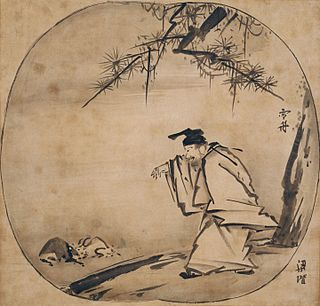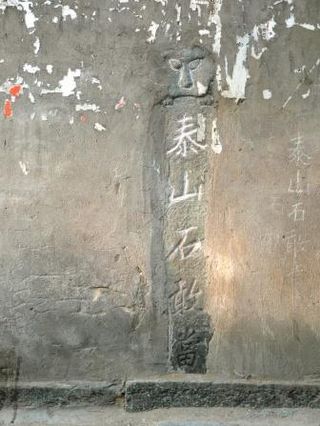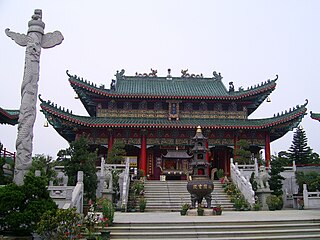
Taoism or Daoism is a diverse philosophical and religious tradition indigenous to China, emphasizing harmony with the Tao—generally understood as an impersonal, enigmatic process of transformation ultimately underlying reality. The concept originates in the Chinese word 道. Although Taoism has no simple definitions, possible translations of Tao include 'way', 'road', and 'technique'. Taoist thought has informed the development of various practices within the Taoist tradition and beyond, including forms of meditation, astrology, qigong, feng shui, and internal alchemy. A common goal of Taoist practice is self-cultivation, a deeper appreciation of the Tao, and more harmonious existence. Taoist ethics vary, but generally emphasize such virtues as effortless action, naturalness, simplicity, and the three treasures of compassion, frugality, and humility.

Wong Tai Sin District is one of the 18 districts of Hong Kong. It is the only landlocked district in Hong Kong. It is located in Kowloon, and is the northernmost district in Kowloon. It borders the districts of Kwun Tong to its southeast, Kowloon City to its southwest, Sai Kung to its east, and Sha Tin to its north.

Wong Tai Sin Temple is a well known shrine and tourist attraction in Hong Kong. It is dedicated to Wong Tai Sin, or the Great Immortal Wong. The 18,000 m2 (190,000 sq ft) Taoist temple is famed for the many prayers answered: "What you request is what you get" (有求必應) via a practice called kau chim. The temple is located on the southern side of Lion Rock in the north of Kowloon.

Wong Tai Sin or Huang Daxian is a Chinese Taoist deity popular in Jinhua, Zhejiang, and Hong Kong with the power of healing. The name, meaning the "Great Immortal Wong (Huang)", is the divine form of Huang Chuping or Wong Cho Ping, a Taoist hermit from Jinhua during the Eastern Jin dynasty.

The Wudang Mountains are a mountain range in the northwestern part of Hubei, China. They are home to a famous complex of Taoist temples and monasteries associated with the Lord of the North, Xuantian Shangdi. The Wudang Mountains are renowned for the practice of tai chi and Taoism as the Taoist counterpart to the Shaolin Monastery, which is affiliated with Chan Buddhism. The Wudang Mountains are one of the "Four Sacred Mountains of Taoism" in China, an important destination for Taoist pilgrimages. The monasteries such as the Wudang Garden were made a UNESCO World Heritage Site in 1994 because of their religious significance and architectural achievement.
Taoism in Singapore is the religion of about 8.8% of the country's entire population as per the 2020 census. The definition of "Taoism" in the country is included as part of the wider Chinese folk religion. In general, nearly all adherents of Taoism in Singapore are associated with the mainstream Zhengyi school. Larger proportion of older residents adhere to Taoism, as compared with those in younger age groups.

The Eastern religions are the religions which originated in East, South and Southeast Asia and thus have dissimilarities with Western, African and Iranian religions. Eastern religions include:
Religion in Hong Kong is characterised by a multi-faith diversity of beliefs and practices.
Moy Lin-shin was a Taoist monk, teacher and tai chi instructor who founded The Taoist Tai Chi Society, the Fung Loy Kok Institute of Taoism and the Gei Pang Lok Hup Academy.

Religion in Taiwan is characterised by a diversity of religious beliefs and practices, predominantly those pertaining to the continued preservation of the ancient Chinese culture and religion. Freedom of religion is inscribed in the constitution of the Republic of China (Taiwan). The majority of Taiwanese people practice a combination of Buddhism and Taoism often with a Confucian worldview, which is collectively termed as Chinese folk religion.

Chuk Yuen or Chuk Un was a village and an area in New Kowloon of Hong Kong. The area located in the approximate area of present-day Wong Tai Sin. The name now also refers to two public housing estates, Chuk Yuen North and Chuk Yuen South Estates.

Lai Chi Wo is a Hakka village near Sha Tau Kok, in the northeastern New Territories of Hong Kong. It is described as a "walled village" by some sources. Lai Chi Wo is located within Plover Cove Country Park and near Yan Chau Tong Marine Park.

The International Taoist Tai Chi Society is an umbrella organization for the governance of its member associations around the world, which are dedicated to the teaching of Taoist Tai Chi. As of 2007, the organization had 40,000 members, including 15,000 in Canada, and was present in 26 countries. Since 2010 the Society refers to Taoist Tai Chi as Taoist Tai Chi internal arts of health.
Articles related to Hong Kong include:

Chinese spiritual world concepts are cultural practices or methods found in Chinese culture. Some fit in the realms of a particular religion, others do not. In general these concepts were uniquely evolved from the Chinese values of filial piety, tacit acknowledgment of the co-existence of the living and the deceased, and the belief in causality and reincarnation, with or without religious overtones.
The Chinese Temples Committee is a statutory body in Hong Kong established in 1928 under the Chinese Temples Ordinance (華人廟宇條例). It is mainly responsible for the operation and management of twenty-four temples directly under its management. It also handles temple registration. There are 20 additional temples, of which management has been delegated to other organisations.

Taoism in Hong Kong is the religion of approximately 14% of the population. This figure did not include the large number of local population who are following Chinese folk religious traditions without indicating their religious affiliation.
A Taoist temple, also called a dàoguàn (道观) or gōngguàn (宫观), is a place where the Tao is observed and cultivated. It is a place of worship in Taoism. Taoism is a religion that originated in China with the belief in immortality, which urges people to become immortal by the form of moral and health cultivation.
Wong Tai Sin Temple may refer to:













